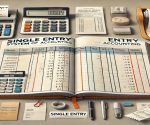The ledger account contains all types of transactions that the entity has had for a specific account in a given period. It is the second step in the accounting cycle, following journal entries. In double entry system, a ledger helps in following debit and credit side of each transaction. It clearly depicts the monetary impact of transactions and aids in preparing final accounts. Ledger is very important for business, students, and professionals in accounting. It ensures that every rupee is rightly accounted. It is not journal because it does not record information date-wise.
What is Ledger Account?
A ledger account is a record in which we write all of the same transactions in one place. It also assists in knowing what was received or paid in all accounts. It also displays the balance after all transactions has been written. Put simply, a ledger is a page in the book for each account. For instance, cash will only be posted in its own account, transactions related to cash will be presented in a Cash Ledger Account. Ledger refer book of record keeping but when you are act as a retailer or wholesaler ledger becomes difficult.
Ledger Definition
Every single business uses this to keep track of money in and out. With double entry, when a transaction is made there is an equal and opposite entry to balance the transaction. So this is why ledger sees both sides of each transaction.
Nonetheless, ledger accounting remains an essential function in their operations.
In accounting, Ledger represents the overall impact of all the transactions of a business. 2. Account balances — The final value of each account. It is used to prepare a trial balance. Then we use that trial balance to prepare the profit and loss account and balance sheet. So ledger plays a vital role of preparing final accounts.
Ledger vs Journal: Key Differences
Students often get confused between ledger vs journal. A journal is the first book of accounts where every transaction is written. It has date-wise entries. We record those transactions in a ledger on an account basis. So, journal is the first entry book and ledger is the final entry book.
| Feature | Journal | Ledger |
| Records | Date-wise | Account-wise |
| Entry Type | First Entry | Final Entry |
| Purpose | For initial recording | For summarising and balancing |
| Format | Debit and Credit with Narration | Separate account with totals |
Why Use a Ledger Account?
A ledger account is useful to know how much money is available in each account. Your rating: Nonee.g. Checking up balances, making trial balance, finding errors etc. Because it provides a detailed view of the expenses, income, assets, and liabilities of each type of expenses, income, asset, and liability, it also aids in decision-making.
Types of Ledger Account
Types of ledger accounts There are various types of ledger accounts. Different Types of Charts As mentioned, each chart type represents a different aspect of the business. All of these types are what accounts fall into. For proper ledgers, it is essential to learn them.
There are primarily three types of ledger accounts. These are:
- Personal Account
- Real Account
- Nominal Account
So, let us understand each of them in detail with an example of ledger account for each.
Personal Ledger Accounts
These are accounts associated with individuals or companies. First of all it contains customers, suppliers, banks, etc. In personal accounts we can see how much we owe or receive from people or businesses.
Example: Suppose we sell goods to Ram on credit. We open Ram’s Account in ledger.
| Date | Particulars | Debit (₹) | Credit (₹) |
| 01-04-2024 | Sales A/c | 10,000 | |
| 15-04-2024 | Cash A/c | 5,000 |
.We sold it to Ram for ₹10,000 and he only paid us ₹5,000. Ram’s balance is ₹5,000. This information is reflected in his ledger account.
Real Ledger Accounts
These accounts show assets. Reason: Assets include cash, furniture, property, land, machinery, etc. These narratives don’t end but continue from year to year.
Example: Cash Account
| Date | Particulars | Debit (₹) | Credit (₹) |
| 01-04-2024 | Capital A/c | 20,000 | |
| 02-04-2024 | Purchase A/c | 5,000 |
This indicates owner brought in money as capital and went out for purchase.
Nominal Ledger Accounts
These accounts reflect income and expenses. At year end, we take them to profit and loss account.
Example: Rent Account
| Date | Particulars | Debit (₹) | Credit (₹) |
| 05-04-2024 | Cash A/c | 2,000 |
And we did so we paid rent in cash.
General Ledger Accounting
These all types of ledgers together are called general ledger accounting. It is the complete list of all accounts. It has both personal accounts, real accounts, and nominal accounts at one place. In short, general ledger accounting manipulates to find the overall financial position of the business.
Steps for Preparing Ledger Account
Journal entries are posted to ledger, to learn preparing ledger we need to know how to do posting. A journal entry consists of both a debit and a credit. We write them in the respective accounts in ledger. This process is known as posting. Now we go into detail about preparing a ledger. Follow these steps:
Step 1 – Write Journal Entry
Using the double entry system, create a journal entry. For example,
Cash A/c Dr. ₹10,000
To Sales A/c ₹10,000
That cash arrived and goods were sold.
Step 2 – Use Appropriate Ledger Accounts
Then, identify which accounts are affected. In this case, Cash and Sales
Step 3 – Post to Ledger
Now, record the debit and credit in their respective ledgers.
Cash Account
| Date | Particulars | Debit (₹) | Credit (₹) |
| 01-04-2024 | Sales A/c | 10,000 |
Sales Account
| Date | Particulars | Debit (₹) | Credit (₹) |
| 01-04-2024 | Cash A/c | 10,000 |
Name the account drawn in the particulars column on the other one.
Step 4 – Balance the Account
At month-end, total both sides. If it’s not the same directions find the balance on practice. Write it on the smaller side. This illustrates what remains or is owed.
Step 5 – Holdover Balance
Roll this balance over to next month. On page 2: After “Balance c/d” (carried down) on one line and “Balance b/d” (brought down) on next.
Ledger Format
Here is what the ledger looks like in its most common format:
| Date | Particulars | J.F. | Debit (₹) | Credit (₹) |
| dd-mm-yyyy | Account Name | 101 | 1,000 | |
| dd-mm-yyyy | Account Name | 102 | 500 |
Cash Ledger Account
| Date | Particulars | Debit (₹) | Credit (₹) |
| 01-04-2024 | Furniture A/c | 5,000 |
J.F. refers to Journal Folio, which tracks the journal entry number.
Example of Ledger Account – Complete Process
Let’s take one more example:
Journal Entry:
Furniture A/c Dr. ₹5,000
To Cash A/c ₹5,000
Furniture Ledger Account
| Date | Particulars | Debit (₹) | Credit (₹) |
| 01-04-2024 | Cash A/c | 5,000 |
Cash Ledger Account
| Date | Particulars | Debit (₹) | Credit (₹) |
| 01-04-2024 | Furniture A/c | ₹5,000 |
Relevance to ACCA Syllabus
Ledger accounts fall under Financial Accounting (FA) and Financial Reporting (FR) of the ACCA syllabus You can make correct double-entry records and develop financial statements by knowing the organization of the ledger account. This foundation is built upon by papers such as Strategic Business Reporting (SBR) and Audit and Assurance (AA). It furthermore aids the evaluation of balances of the Statement of Financial Position.
Ledger Account ACCA Questions
Q1: In double-entry bookkeeping, what is the key function of a ledger account?
A) To prepare trial balance
B) The purpose of recording original transactions
C) To reveal financial results
D) To post adjusting entries
Answer: A) Trial balance preparation
Q2: In accounts such as a ledger, where would “Wages Expense” be?
A) Personal Account
B) Real Account
C) Nominal Account
D) Asset Account
Answer: C) Nominal Account
Q3: How are ledger accounts usually presented?
A) Journal format
B) Tabular format
C) T-account format
D) Narrative format
Answer: C) T-account format
Q4: What would be correct journal entry for paying rent in cash?
A) Rent A/c Dr, To Cash A/c
B) Cash A/c Dr, To Rent A/c
C) Rent A/c Dr, To Bank A/c
D) Bank A/c Dr, To Rent A/c
A) Rent A/c Dr, To Cash A/c
Q.5: Which document is used to transfer the transactions from journal to ledger?
A) Trial Balance
B) Ledger Book
C) Journal Folio
D) Posting Sheet
Answer: C) Journal Folio
Relevance to US CMA Syllabus
For example, in Part 1 of the CMA exam, ledger accounts are key in the area of External Financial Reporting Decisions. Using this information, candidates need to know how to document financial records via double-entry accounting, and know how to interpret balances reflected in general ledger format to prove compliance with U.S. GAAP. These are used as the basis for budgeting, performance evaluation, and making financial decisions.
Ledger Account CMA Questions
Q1: What does the credit side of a liability account in the ledger record?
A) Increases
B) Decreases
C) Expenses
D) Revenues
Answer: A) Increases
Q2: Which financial report is best supported by a general ledger format?
A) Income Statement
B) Statement of Cash Flows
C) Balance Sheet
D) Management Report
Answer: C) Balance Sheet
Q3: The next process after posting of the journal entries into ledger accounts?
A) Prepare income statement
B) Prepare cash flow
C) Prepare trial balance
D) Prepare closing entries
Answer C) Prepare trial balance
Q4: What to do if an entry went to the wrong ledger account?
A) Delete the entry
B) Create a reversing entry
C) Leave it as it is
D) Change journal entry
answer is B) Create a reversing entry
Q5: Ledger account balances are useful in preparing which important accounting report?
A) Ratio analysis
B) Ledger summary
C) Trial balance
D) Payroll sheet
Answer: C) Trial balance
Relevance to US CPA Syllabus
In Financial Accounting and Reporting (FAR) section in US CPA exam.They need to know the mechanics of posting transactions, how to classify accounts (assets, liabilities, equity) and how the entries affect financial statements. These fundamental principles of the ledger are vital to ensuring accuracy in financial reporting.
Ledger Accounts US CPA Questions
Q1: Why is double entry ledger format important in accounting records?
A) Reduced costs
B) Balanced records
C) Income is maximized
D) Transactions are coded
Answer: B) Balanced records
Q2: What type of ledger account is “Accounts Receivable”?
A) Liability
B) Asset
C) Expense
D) Nominal
Answer: B) Asset
Q3: What is typically the first step in the accounting cycle?
A) Ledger posting
B) Preparing trial balance
C) Making journal entries
D) Preparing financial statements
Answer: C) Making journal entries
Q4: On which side of a ledger account example are expense entries recorded?
A) Left (Debit)
B) Right (Credit)
C) Center
D) No fixed side
Answer: A) Left (Debit)
Q5: What is a document that summarizes all of the ledger balances?
A) Ledger account template
B) General journal
C) Income statement
D) Trial balance
Answer: D) Trial balance
Relevance to CFA Syllabus
Accounting Systems structure under the Financial Reporting and Analysis section of the CFA Level I exam Ledger accounts enable the construction of precise financial statements and assist in understanding income and equity and balance sheet items. It also paves the way for understanding cash flow analysis and ratio interpretation.
Ledger Account CFA Questions
Q1: What does a ledger account show in financial statements?
A) Market price of assets
B) Income projections
C) Historical transactions
D) Tax rates
Answer: C) Historical transactions
Q2: What ledger account would “Sales Revenue” affect?
A) Liability Account
B) Equity Account
C) Nominal Account
D) Asset Account
Answer: C) Nominal Account
Q3: What are the significance for the investors about the ledger account format?
A) It increases dividends
B) THIS HAS A VISIBILITY ON PRICE PREDICTION
C) It promotes the accurate reporting
D) It has an impact on government policy
Ans: C) It supports accurate reporting
Q4: What principle of accounting states that for every debit there is an equal and opposite credit?
A) Time Period Principle
B) Cost Principle
C) Matching Principle
D) Double Entry Principle
Answer: D) Double Entry Principle
Q5: What report can be impacted by inaccurate posting to the ledger?
A) Industry benchmark
B) Financial statements
C) Marketing budget
D) Press release
Answer: B) Financial statements


